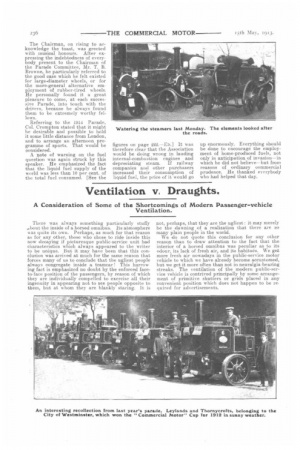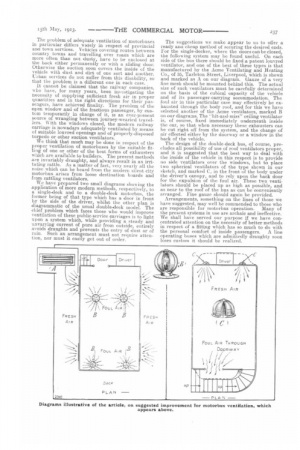Ventilation v. Draughts.
Page 18

Page 19

If you've noticed an error in this article please click here to report it so we can fix it.
A Consideration of Some of the Shortcomings of Modern Passenger-vehicle
Ventilation.
There was always something particularly stuffy .,..bout the inside of a. horsed omnibus. Its atmosphere was quite its own. Perhaps, as much for that reason as for any other, those who chose to ride inside this now decaying if picturesque public-service unit had characteristics which always appeared to the writer to be unique. But it may have been that this conclusion was arrived at much for the same reason that forces many of us to conclude that the ugliest people always congregate inside a tramcar This harrow. ing fact is emphasized no doubt by the enforced faceto-face position of the passengers, by reason of which they are individually compelled to exercise all their ingenuity in appearing not to see people opposite to them, but at whom they are blankly staring. It is not, perhaps, that they are the ugliest : it may merely be the dawning of a realization that there are so many plain people in the world. We do not quote this conclusion for any other reason than to draw attention to the fact that the interior of a horsed omnibus was peculiar as to its odour, its lack of fresh air, and its habitues. We get more fresh air nowadays in the public-service motor vehicle to which we have already become accustomed, but we get it more often than not in neuralgia-beating streaks. The ventilation of the modern publie-service vehicle is contrived principally by some arrangement of primitive shutters or grids placed in any convenient position which does not happen to be required for advertisements.
The problem of adequate ventilation of motorbuses in particular differs widely in respect of provincial and town services. Vehicles covering routes between country towns and travelling over roads which are more often than not, dusty, have to be enclosed at the back either permanently or with a sliding door. Otherwise the suction soon covers the inside of the vehicle with dust and dirt of one sort and another. Urban services do not suffer from this disability, so that the problem is a different one in each case, It cannot be claimed that the railway companies, who have, for many years, been investigating the
necessity of supplying sufficient fresh air in proper quantities and in the right directions for their passengersi have achieved finality. The problem of the open window and of the fractious passenger, by cus
tom temporarily in charge of it, is an ever-present source of wrangling between journey-wearied travel lers. With the windows closed, the modern railway carriage is nowadays adequately ventilated by means of suitable louvred openings and of properly-disposed torpedo or other suction ventilators.
We think that much may be done in respect of the proper ventilation of motorbuses by the suitable fit ting of one or other of the best forms of exhausters which are available to builders. The present methods are invariably draughty, and always result in an irri tating rattle. As a matter of fact., veiy nearty all the noise which can be heard from the incident silent city motorbus arises from loose destination boards and from rattling ventilators. We have prepared two small diagrams showing the application of more modern methods, respectively, to a single-deck and to a double-deck motorbus, the former being of that type which has a door in front by the side of the driver, whilst the other plan is diagrammatic of the usual double-deck nicxlel. The chief problem which faces those who would improve ventilation of these public-service carriages is to light upon a system which, while providing a steady and unvarying current of pure air from outside, entirely avoids draughts and prevents the entry of (lust or of rain. Such an arrangement must not require attention, nor must it easily get out of order. The suggestions we make appear to us to offer a ready and cheap method of securing the desired ends. For the single-decker, where the ctoors can be closed, the following system may be found useful. On each side of the bus there should be fixed a patent louvred ventilator, and one of the best of these types is that manufactured by the Acme Ventilating and Heating Co., of 35, Tarleton Street, Liverpool, which is shown and marked as A on our diagram. Gauze of a very fine mesh should be mounted behind this. The actual size of such ventilators must be carefully determined on the basis of the cubical capacity of the vehicle and of its passenger-carrying accommodation. The foul air in this particular case may effectively be exhausted through the body roof, and for this we have selected another of the Acme ventilators, marked B on our diagrams. The "bit-ancl-rniss" ceiling ventilator is, of course, fixed immediately underneath inside the car, so that when necessary these exhausters can he cut right off from the system., and the change of air effected either by the doorway or a window in the back of the vehicle.
The design of the double-deck bus, of course, precludes all possibility of use of roof ventilators proper, and it is suggested that the best way to deal with the inside of the vehicle in this respect is to provide no side ventilators over the windows, but to place two spherical ventilators of the type shown in our sketch, and marked C, in the front of the body under the driver's canopy, and to rely upon the back door for the expulsion of the foul air. These two ventilators should be placed up as high as possible, and as near to the roof of the bus as can be conveniently arranged. Fine gauze should again be provided. Arrangements, something on the lines of those we have suggested, may well be commended to those who are responsible for motorbus operation. Many of the present systems in use are archaic and ineffective. We shall have served our purpose if we have concentrated attention on the necessity of better methods in respect of a fitting which has so much to do with the personal comfort of inside passengers. A line operating buses which are admittedly draughty soon loses custom it should be realized.


























